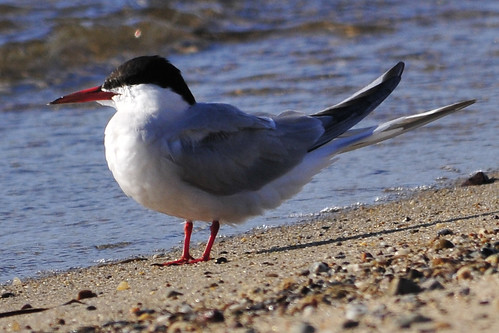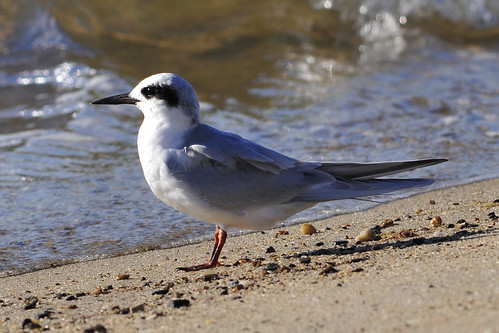
I have always thought that terns are graceful, elegant, and beautiful birds. It can be a real challenge to distinguish between tern species, however. Even in the best of circumstances (which would be when all are in breeding plumage and posing exactly as they do in a field guide), it can be virtually impossible to correctly ID all the terns you see. For an amateur tern aficionado like myself, every correctly identified tern is a major triumph. I'm not alone in having problems, either. In the Advanced Birding Peterson Field Guide, there is a chapter on The Medium-sized Terns about Common Terns, Roseate Terns, Arctic Terns and Forster's Terns. Our local terns, in other words. I wouldn't have known this was a Forster's Tern in breeding plumage if a knowledgeable birder and photographer named Myer Bornstein, aka photo Bee1 on Flickr,hadn't told me.

Identifying breeding adult terns is nothing compared to trying to ID these terns in September, however. Adult terns are molting. Juvenile terns are hard to identify at the best of times, and in September they are changing every day. I have spent countless hours staring at pictures and consulting every book in my arsenal, but for the most part I can't figure out what species of terns we saw and photographed last weekend!

This one I know is a non-breeding Forster's Tern. I only know this because a truly expert birder, known as corvid01 on Flickr, made the identification for me. The really good news is that one of my goals for our weekend birding expedition was to see a Forster's Tern. The bad news is that I didn't know I had seen one.

All four species bills turn black in winter, making bill color pretty worthless as a field mark in the fall. Head patterns also change in the fall for all four species. Some of the black caps will turn partially white for the winter, so head patterns are in flux during September, too. This bird has an almost all black bill, dark (possibly black) legs, and what looks like a long white tail. If it were June, those clues would have suggested a Roseate Tern. In September, I can't even hazard a guess!

I'm guessing Forster's here because of the eye patch look, but it is just a guess. At this rate, I will be a student of terns forever, never mastering the subtleties of the true birder. I'm OK with that, actually. I enjoy learning things more than knowing things in most cases. On the other hand, if anyone out there can help, please do!

very nice post and photos, Terns are tough
ReplyDeleteOutstanding photos! I haven't even had a chance to get a close up look at terns to have a try-except for common and least.One of these days I'll give it a shot-nice post.
ReplyDelete